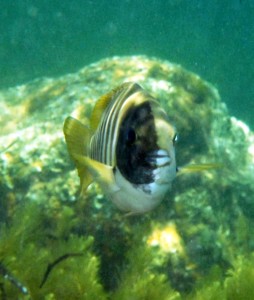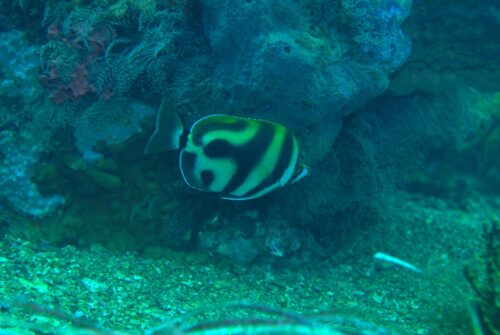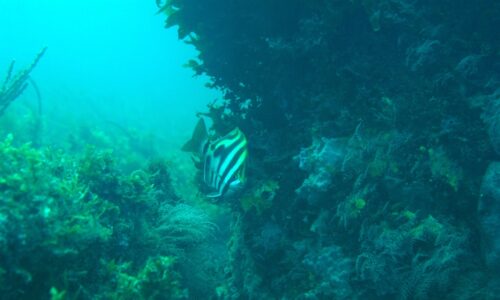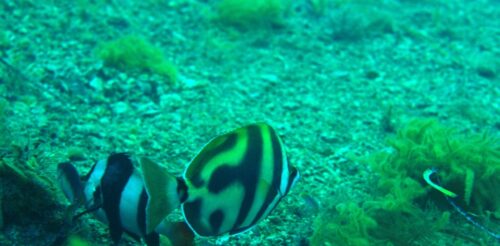More peculiar colour patterns in fish
(Mostly as told to Steve Reynolds by David Muirhead)
I described a most peculiar colour pattern in zebra fish, Girella zebra in A Most Peculiar Colour Pattern in Zebra Fish (as told to Steve Reynolds by David Muirhead).

Cropped image of the Zebra Fish with a ‘most unusual colour pattern’
(Taken by David Muirhead at Lady Bay on 27th October 2010)
An even more peculiar colour pattern in a South Australian fish species has since been discovered by David Muirhead. This time it was a moonlighter, Tilodon sexfasciatus, at Rapid Bay.
David reported the sighting on iNaturalist at https://www.inaturalist.org/observations/38663757 as follows: –
“Now this is one unusual adult Moonlighter! It has normal markings on one side (its left side if you are the fish)”
(This) was my only shot of this individual’s normal looking side: –

“(This) pic clearly shows its weirdly patterned right flank, as do a few other pics …… “: –

“This is a first for me where moonlighters are concerned. But the asymmetry [in an otherwise normal looking, apparently healthy fish which also behaved normally, including mixing briefly with one or two similar sized adults, of which there were many on this dive] immediately reminded me of the occasional surprise encounters I’ve had with odd-looking zebrafish.

“[Those morphs had asymmetrical black head markings as the main visual cue setting them apart from their companions, and several of my asymmetrically coloured and marked zebrafish observations are already available for viewing on iNat’s Australasian Fishes Project.].

“Despite much interest and speculation as to cause, no firm explanation ever reached consensus for the asymmetrically patterned zebrafish. Some of the hypotheses we discussed included random mutations, and various pathological processes e.g. congenital abnormality, or superficial fungal infection causing discoloration, but there were others…anyone interested please view the relevant zebrafish observations then add their thoughts…..”

Yet another peculiar colour pattern in a fish species came to light during discussions on iNaturalist. Video footage found at https://australianmuseum.net.au/learn/animals/fishes/luderick-girella-tricuspidata/ “shows one of the annual Luderick, Girella tricuspidata, spawning aggregations in Queensland. …….. The male Luderick have adopted a pale body colouration with a dark head. They are closely following the ‘ripe’ females that have retained the ‘normal’ barred body pattern.”
Meanwhile, researchers suspect that a pink manta ray spotted near Lady Elliot Island has a genetic mutation that gives it a rosy hue. The manta ray has been given the name “Inspector Clouseau”. Project Manta is now pursuing the hypothesis that perhaps Clouseau’s pink colour is the result of a genetic mutation that affects skin pigmentation. Such mutations are fairly common in the animal world, including among fish, as well as humans with albinism. One variant called erythrism can give skin a reddish or pinkish hue. Visit https://www.smithsonianmag.com/smart-news/rare-pink-manta-ray-spotted-near-australias-lady-elliot-island-180974196/ for more details.


[…] I was happy to see a few good-sized Moonlighters, Tilodon sexfasciatus, swimming beneath the old Rapid Bay jetty during my dive on 5th June 2020. I was also very surprised to see the unusual Moonlighter previously seen by David Muirhead, as reported in More peculiar colour patterns in fish. […]